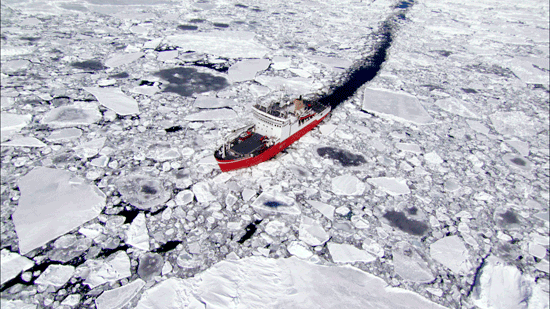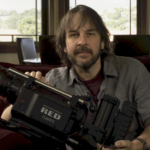
Ice Patrol
Posted on Apr 27, 2010 by Alex Fice
Ice Patrol featured HMS Endurance’s journeys in Antarctica
Picture Gallery (32 images)
Ice Patrol is another reality series that observes part of the HM Forces in action and navigates the difficult path between capturing the interest while not upsetting the hosts. The idea for Ice Patrol was to spend months on board HMS Endurance, the Royal Navy’s only ice cutter on its duties in and around Antarctica.
You can understand why the producers thought this was a good idea. HMS Endurance is a unique ship with a unique mission in an area of the world that still holds mysteries and a huge amount of political intrigue. Throw in the lives of 120 men and women with that intriguing backdrop and the hope is that you’ll be spoilt for your shooting opportunities.
That was certainly the case in this four part series that was originally flagged with six parts.
The reason for the missing episodes was the near sinking of the boat in question, a dramatic part four describes the events after trailing them throughout the first three parts. What was a friendly semi-PR exercise for the Royal Navy turned in to a major recovery including international navies and only minutes before abandonment of the ship. The film crew however was flown off the ship at the first sign of the emergency, but a local crew managed to shoot some coverage – an interview with one of the main officers was also managed after all were safe.
So how to shoot such a series? DoP Steven Gray came on board with a huge amount of experience of shooting with high definition going back to 1996 with NHK in Japan. “I’ve been shooting HD since 1996. I was with NHK when they had the Hi-Vision units – that was a one inch tube camera. I did a couple of documentaries for them in that format in London and then went to Iceland using a three chip camera and a 3/4in U-Matic style deck, again that was high-def all for NHK. Since then I’ve used all the major HD cameras.
“This job had to look good but they also needed someone who could work in fairly difficult environments. The brief was that we were going to spend two work periods with the ship either side of Christmas but obviously because of the incident with the ship the third and fourth periods didn’t happen.
The idea was that we were going in to film an observational documentary about life on the ship and what they get up to down in Antarctica.
“The style was to be a mixture of observational filming but with great landscape shots and good environment shots. We wanted to have a good cinematic feel to catch the landscape. They could have done it all with say a Sony EX1 but they felt that they also wanted to capture the grandeur with a camera with proper lenses.”
A Sony PDW 700 XDCAM HD camera was chosen and fitted with Canon HD lenses.
To support this idea of cinematic visuals came the help of a stabilized Gyron system attached to one of the Lynx helicopters through David Ballie of Wildcat Flying. David was shooting from a Sony HD head to a STWO hard drive system.
AERIALS
The use of the Gyron separated Ice Patrol from your average documentary and was used sparingly but very effectively to emphasise the majesty of the environment. A style much copied from the great BBC wildlife series like Planet Earth.
“There was a mixture of the Gyron and the Portamount which I got from Flight Logistics. Quite a few shots of the ship were done with that mount and the overflying of the Shackleton walk were done with that.”
Getting rigs on to Navy helicopters take an enormous amount of permissions mostly to do with load bearing.
Steven looked at a few options once they knew they had got time on the Lynx, “We talked about taking down a proper stabilised side mount but were told they couldn’t bolt anything on to the helicopter. Once it gets bolted on it becomes part of the machinery and has to be tested.
“Flight Logistics suggested the Portamount which is basically a little monopod with a series of springs and oiled dampers. You just pop it between your legs and then harness yourself, the camera and the mount, then you put a tripod plate on the top and it takes out the vibrations. It’s not fully stabilised but it does help and if you’ve got the door open for a couple of hours you don’t want to be holding the camera in your hands. When the helicopter vibrated a lot it was a problem but if you kept on the wide end of the lens it was good.”
Other gear including a ‘swing away’ Mattebox from Arri. “The big thing when you’re filming in a cold environment is you don’t want to take your gloves off too often. A ‘clip on’ Mattebox will have to be taken off and put on the ground and gloves have to come off to do that. With the Arri one you can take the lens off, change it and off you go. It allowed me to use good filter for the landscape shots.”
Steven was using Polarizers for the landscape shots and grads and often flipping the grad so it would take down the exposure on the snow. “I would be using an ND9 grad for the sky, then an ND6 for the snow, leaving the centre strip clear.”
CHOOSING TAPELESS
Steven had experienced severe cold before with HD tape systems and with that came the moisture which sometimes wreaked havoc with the tape heads. “I have problems with that in lots of environments whether its hot, humid or cold and damp. The tape situation was a worry because we were based on the ship, the cameras would be stored inside because we couldn’t store them outside in that environment. To then go outside on to the ice or onto land would be subjecting the cameras to a wide range of temperatures. I knew I’d get issues with the lenses all the time but I thought if we go down the route of actually having a disc camera, as there are no moving parts the laser will burn off any issues straightaway.
The other was the amount of stock we had to take down in terms of size and weight was a lot smaller with discs. The disc record up to about three hours and you are immediately reducing the size of the box you are taking down with you on the flight down to the Falklands. Also when you’re moving around with a rucksack you got a couple of days worth of shooting stock at the size of small book effectively.
“Also the post production process was to cut while they were on the ship. We took an editor down with us with a laptop and a series of hard drives. Every night we would transfer the footage from the camera at the highest resolution possible so they could cut at full resolution on the ship.
We did that directly from the camera so we didn’t have to take down any expensive playback decks. You could say you can do that with a tape based camcorder but I never like putting a tape back in a camera because if it gets chewed up in the camera then you’re stuck. Whereas a disc – no problems at all.”
HD CHOICE
As for the choice of format for the series Executive Producer Rosie Kingham had no doubt where they were headed. “We knew we had to go high definition because everything is HD now. There was no question that we weren’t going to film HD particularly in that kind of environment. We had spoken to our post production facility about how we would do this and how we would get material back because you can’t send huge amounts of material from Antarctica, we get very limited satellite reception. Loading material up on a site was impossible.
“Going down there with tapes say with a Sony f900 or something and being out on the ice for long periods of time we were limited with what we could take with us. What became apparent was when you actually went out on to the ice the most important things you had with you were your survival packs. So kit for us out on the ice in terms of what we could carry was very limited.
“It was all about what we could handle ourselves and the only way we could achieve it was to go tapeless.
The discs don’t weigh anything, you can get them in and out quickly and you can store enormous amounts of material on them. It was much more flexible to move around and film like that than taking tapes because they would have taken up too much room.”
It was agreed that the production would be enhanced by editing in location so an Avid editing station was set up in a room on board and footage was downloaded after every day’s shooting or as and when they needed to and backing up was to hard drives. It was only after the first trip to the ice when they returned to the Falklands to re-stock the ship that they were able to send back via courier the hard drives to an edit suite.
As to using HD tapeless again Rosie is unequivocal in her answer, “I think it’s fabulous, I would definitely use it again. I would prefer to work this way than a tape based camera. We never experienced any problems with the discs. Tapeless is a fantastic way of filming especially in an environment like that.”
Rosie and the Director Martin Kemp handled the Sony EX3 footage and Rosie for one found the experience relatively straightforward, “It took me a little while to get the hang of it. The light down there varies so much, you’re going from inside where you have an awful orange light and then outside to this stark, white, pristine, extreme sunlight. Sometimes you can’t take out enough even with the filters. So you’re constantly adjusting and that’s quite hard, but the EX3 was very good.”
MATCHING FORMATS
Ultimately Steven did very little shooting with the EX3, so was he happy that the two cameras matched in the final edit. “I’ve seen enough stuff that was cut together that it was an acceptable compromise of quality. Obviously there is a difference but in terms of what the audience see, the small camera gives you a certain immediacy which allowed you to shoot in very constrain environments and allowed the producer and director to get stuff that was of a good enough quality.”
With only three cameras, thousands of miles from any service centre Steven did have a plan B if the PDW 700 broke down, “We were probably two weeks away from any spare parts or help coming down to us, so with the EX3 which has interchangeable lenses I got an adaptor which would allow me to use the 2/3in lenses I had for the big camera, the Canon HJ22 and HJ11. We also had the Matte Box and filters so if we did have a problem we could carry on shooting with the EX3 and still use the big lenses and accessories for landscape shots.
“Luckily we never had to do it but it was a good compromise solution as the budget didn’t allow for another camera body.”
What ultimately did Steven think of the PDW 700 and the XDCAM HD compression scheme? “I think the compression is perhaps a little bit too heavy. I would be interested to take it in to the jungle for instance. The good thing about Antarctica is there is not much that moves apart from the sea and penguins. There’s aren’t things like grass and trees that blow in the wind. It was very suited to that particular project.
“Using the disc camera is good because it’s a kind of stepping stone, you still at the end of the day have something in your hands. With the EX3s and the Panasonic P2s and the REDs you don’t actually have anything solid in your hand and say ‘that’s what I shot today’.”
Ice Patrol is a great triumph for tapeless technology more perhaps for its practicalities than the technology behind it. But you can’t deny that the Antarctic environment is a testing ground for most technology and tapeless has passed with flying colours and resulted in an engaging mix of personal tales and cinematic arctic landscapes.
HD Week – Michael Caine in HD / Tapeless Times in Antarctica / BSC Evaluation







